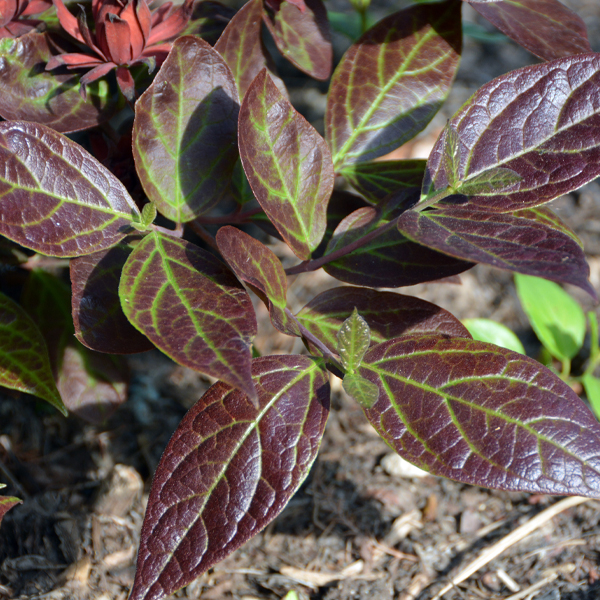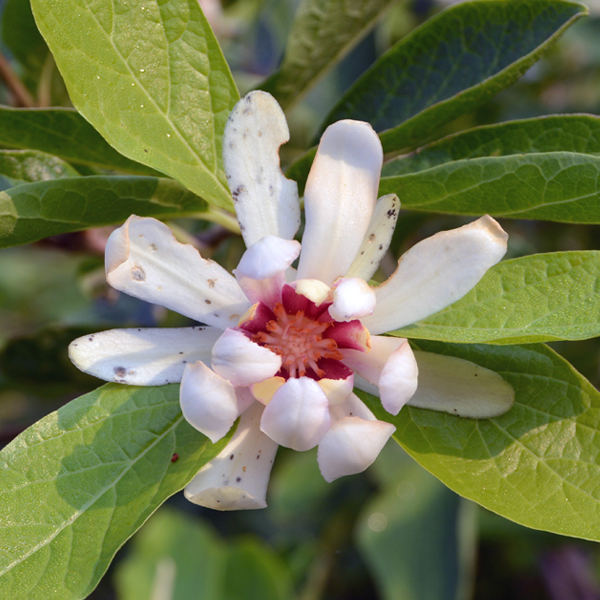

A Comparative Evaluation of Sweetshrubs
A Comparative Evaluation of Sweetshrubs (Calycanthus) | Issue 50 2024
Jack E. Nicholson, Plant Evaluation Assistant

Calycanthus occidentalis
When choosing fragrant shrubs, lilacs, roses, or mock oranges immediately come to mind for northern gardeners, but perhaps the most delightful scent of all belongs to another, more obscure contender. The magnolialike blossoms of sweetshrubs (Calycanthus spp.) offer an unusual fruity, spicy aroma. The eastern sweetshrub (Calycanthus floridus) was long cultivated in American gardens for its beauty and fragrance, but this classic has been reinvigorated through hybridization with the Chinese sweetshrub (C. chinensis) and western sweetshrub (C. occidentalis) to produce plants featuring larger, showier flowers with the same appealing scent.
Calycanthus belongs to Calycanthaceae, a small family containing the three sweetshrub species, the wintersweets (Chimonanthus spp.), and the idiot fruit (Idiospermum australiense), a rare tree native to Australia. Sweetshrubs and their relatives are in a larger clade known as magnoliids, which includes magnolias and other primitive flowering plants such as bay laurel, avocado, pawpaw, and cinnamon. Sweetshrub flowers resemble those of magnolias and, like them, possess spirally arranged, undifferentiated petals and sepals collectively referred to as tepals. Sweetshrubs and magnolias also share a reliance on beetles for pollination, having diverged from most other flowering plants (eudicots and monocots) in the early Cretaceous Period before the evolution of bees. The fragrance of Calycanthus flowers is thought to be an adaptation to attract beetles looking to feast on fermenting fruit.
Sweetshrubs are medium- to large-sized deciduous, suckering shrubs generally reaching 6 to 12 feet tall and wide. Their leaves are simple, oppositely arranged, and ovate to elliptical in shape with entire margins. The axial surface has a rough texture and somewhat glossy appearance, Both the leaves and bark emit a spicy, camphor-like scent when crushed.
Flowers are borne singly in late spring on last year’s growth and continue to bloom more sparingly on new growth through midsummer. The fruit is unusual but not particularly ornamental—an elliptical, 2- to 3-inch drooping capsule resembling a chrysalis or dried-up fig, which persists through winter and into the next season.
The eastern sweetshrub or Carolina allspice (Calycanthus floridus), native to the southeastern United States, produces the delectable, fruity fragrance from which sweetshrubs derive their common name. The aroma is perceived differently from person to person but is often likened to strawberry, banana, pineapple, melon, and bubblegum with hints of spice. The quality and intensity of fragrance varies between individual plants, with some specimens having little to no scent or even a disagreeable one. The flowers of eastern sweetshrub measure 1½ to 2 inches in diameter, and are made up of narrow, brownish red tepals. Cultivars of eastern sweetshrub have been selected for consistent, pleasing fragrance among other ornamental traits such as purple foliage (‘Burgundy Spice’ and ‘Purpureus’) or yellowish green flowers (‘Athens’).
The other two species of sweetshrub are uncommon in cultivation but serve as parents for the more popular hybrids. The western sweetshrub or California allspice (Calycanthus occidentalis), native to central and northern California, is similar in appearance to the eastern sweetshrub, but its flowers are ruby red and give off the scent of wine or vinegar. The Chinese sweetshrub or Chinese wax shrub (C. chinensis) hails from southeastern China. It has bigger leaves and large, camellia-like flowers— up to 3 inches across—composed of broader white to light pink tepals surrounding a ring of waxy yellow inner tepals, which lack any fragrance. Due to its morphological and geographical disparity, it was formerly classified in its own genus as Sinocalycanthus chinensis but has since been shown to be closely related to the North American species.
Breeders have introduced selections combining the color and fragrance of the North American species with the larger flowers of the Asian species. The first interspecific hybrid was bred by Richard Hartlage, then a student at North Carolina State University (NCSU), when he crossed Calycanthus floridus with C. chinensis to produce C. ×raulstonii— initially considered an intergeneric hybrid dubbed ×Sinocalycalycanthus raulstonii. The original cultivar released from this cross, ‘Hartlage Wine’, bears his name. The nothospecific epithet raulstonii honors the late Dr. J. C. Raulston, former professor and arboretum director at NCSU. Dr. Tom Ranney, professor of horticultural science at NCSU, has continued breeding Calycanthus, producing ‘Aphrodite’, a hybrid between C. occidentalis and C. chinensis, and ‘Venus’, which has parentage from all three species.
Sweetshrubs are low-maintenance garden specimens capable of thriving in many situations. Sweetshrubs can grow in full sun to shade, with shaded plants having a taller, more open habit. In hotter climates, sweetshrubs do best sheltered from the afternoon sun. They prefer moist to medium, well-drained, loamy soil, and can tolerate clay soils but may struggle in sandy, nutrient-poor ones. Sweetshrubs have few pests and disease problems, as their aromatic foliage is unappetizing to herbivores. Pruning may be necessary to maintain symmetry and control size. Errant branches may be cut back any time of year, but waiting until blooming is complete will preserve more of the next year’s flower buds produced on old wood. Suckers should also be pruned as they emerge unless spreading is desired, or they can be transplanted in fall or early spring to propagate a new plant. Calycanthus floridus is hardy in USDA Zones 4-9, and C. occidentalis and C. chinensis are hardy in Zones 6-9 and 6-8 respectively. Hybrid selections are intermediate in hardiness, rated for Zones 5-9. Sweetshrubs are ideal for use in hedges, foundation plantings, and mixed shrub borders. Site near a porch, patio, or walkway to best appreciate their delicious fragrance.
List of Sections
The Evaluation Study
Performance Ratings
Top-rated Sweetshrubs
Observations
Summary
References
Christenhusz, Maarten J. M., et al. Plants of the World. Kew Publishing, 2017.
North Carolina Extension Gardener Plant Toolbox, N.C. Cooperative Extension [plants.ces.ncsu.edu]
Proctor, Michael, et al. The Natural History of Pollination. Timber Press, Inc., 1996.
Soltis, Douglas E., et al. Phylogeny and Evolution of Angiosperms. Sinauer Associates, Inc., 2005.
Special recognition to all the plant evaluators and photographers who contributed to this report: Patrick Dahl, Richard Hawke, Andrew Munoz, Jack Nicholson, Jim Ault, and Gavin Young.
Front cover: Calycanthus ×raulstonii ‘Dark Secret’















![Calycanthus floridus SIMPLY SCENSATIONAL® [‘SMNCAF’] (courtesy of Spring Meadows Nursery)](/sites/default/files/2024/10/02/calycanthus-floridus-simply-scensational_600x600.jpg)



